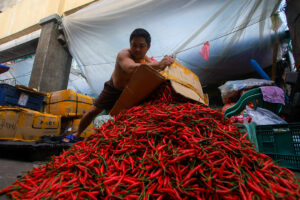GDP growth may miss top-end goal
PHILIPPINE economic growth is unlikely to reach the upper end of the government’s 5.5-6.5% target this year amid higher US tariffs and slowing remittances, analysts said.

By Aubrey Rose A. Inosante, Reporter
PHILIPPINE economic growth is unlikely to reach the upper end of the government’s 5.5-6.5% target this year amid higher US tariffs and slowing remittances, analysts said.
Foundation for Economic Freedom President Calixto V. Chikiamco said hitting the 6.5% mark is “possible, but improbable.”
“More so with [US President Donald J.] Trump tariffs on our key exports and a global economic slowdown,” Mr. Chikiamco told BusinessWorld.
The economy grew by an annual 5.5% in the April-to-June period, supported by a rebound in agriculture production and faster household consumption.
For the first half, gross domestic product (GDP) growth averaged 5.4%, slower than the 6.2% a year ago.
Economic Secretary Arsenio M. Balisacan said the economy must grow by 5.6% in the second half to achieve the low end of the full-year target, and by 7.5% to hit the upper end of the goal.
“However, if the administration keeps its same steady as you go approach, the likelihood is that not only will the government fail to reach its minimum 6% growth target, but actually achieve less than 5.5% growth,” Mr. Chikiamco said.
John Paolo R. Rivera, a senior research fellow at the Philippine Institute for Development Studies, said the required 7.5% average growth in the July-to-December period is a “stretch goal but not impossible.”
“It will require strong export performance despite global headwinds, faster infrastructure rollout after the election spending ban, and sustained household and investment spending,” he said in a Viber message over the weekend.
Mr. Trump imposed a 19% export levy on goods from the Philippines, as well as Cambodia, Malaysia, Thailand, and Indonesia. This took effect on Aug. 7.
“With the tariff rate on the Philippines’ goods being in line with other ASEAN (Association of Southeast Asian Nations) emerging markets, the Philippines risks losing the opportunity of increasing its market share in the US,” HSBC economist for ASEAN Aris D. Dacanay said.
Mr. Dacanay said the strong growth in exports is unlikely to be sustained in the next semester.
“But unlike private consumption, we do not think this strong performance will be sustained. The robust performance was a result of frontloading of import demand across the globe in anticipation of higher US tariffs,” he said.
However, BMI said Philippines is well-insulated from the US tariffs “exports-wise,” but there is a possibility of Mr. Trump raising the tariffs if the Philippines fails to spend at least 5% of its GDP on military spending.
“If Trump threatens a higher tariff because of the nonfulfillment, we anticipate a further slowdown in export growth for the Philippines,” BMI said.
Mr. Rivera said he expects softer export growth, especially for sectors like electronics, garments, and agriculture.
“However, the full effect will likely be gradual, as existing orders and contracts still work through the pipeline,” he said.
“The extent of the slowdown will depend on how fast exporters can adjust either by negotiating better terms, shifting to other markets, or moving up the value chain.”
REMITTANCE SLOWDOWN
Analysts said slowing remittances from overseas Filipino workers (OFWs) may hurt consumer spending in the second half.
“A slowdown in remittances will weigh on private consumption while heightened global uncertainty will continue to chill,” Fitch Solutions’ unit BMI said.
Household final consumption, which accounts for over 70% of the economy, jumped by 5.5% in the second quarter. It was the fastest since the 8.1% growth in the first quarter of 2023.
BMI sees private consumption to grow by 5% in 2025.
“About 40% of remittances come from the US and President Donald Trump has clamped down on immigration and imposed a 1% tax on remittances. Remittances, therefore, are likely to continue dragging on consumption growth in the coming months, diminishing the positive effects of easier monetary policy,” BMI said.
The Bangko Sentral ng Pilipinas (BSP) expects cash remittances from OFWs to grow by 2.8% this year and by 3% in 2026.
The US will start imposing a 1% excise tax on cash-based remittances from the US to recipients abroad on Jan. 1, 2026.
BMI said it kept its GDP forecast at 5.4% for this year, but lowered its 2026 projection to 5.2% from 6.2% for 2026 due to slower remittances and tariff uncertainty.
“The upshot is that we maintain our relatively downbeat forecast for fixed investment to expand by 4.5% in 2025, well below the 12.4% over 2015-2019,” it said.
Nomura Global Markets Research said GDP growth will likely slow to 5.2% in the second half but kept its full-year forecast at 5.3%.
“We believe private investment spending will be more subdued, as businesses turn more cautious owing to surging global trade policy uncertainty and an increasingly challenging operating environment,” Nomura said.
“In the same vein, we expect goods export growth to slow due to the impact of US tariffs but acknowledge rising downside risks particularly from sectoral tariffs on semiconductors in the coming quarters.”
Last week, Mr. Trump announced plans to impose tariffs on semiconductors shipped to the US but offered to exempt companies manufacturing in the US or those that commit to do so, Reuters reported.
Meanwhile, Chinabank Research said it expects growth “to remain modest” as external prospects may remain subdued, given persisting uncertainties and rapidly changing global policies.
“Moving forward, downside risk to growth will be centered on external trade as elevated policy uncertainty and higher tariffs weigh on global economic activity,” it said in a policy note on Thursday.
On the demand side, Chinabank anticipates that government spending will likely continue to quicken for the rest of the year.
“We could see a rebound in the coming quarters as the government ramps up delayed projects and as the effects of interest rate cuts further materialize.”
Nomura said it expects the BSP to cut its policy rate by 25 bps at its Aug. 28 meeting and by another 25 bps in October.
“This would take the policy rate to 4.75% this year, which we think puts BSP’s monetary stance below its estimate of neutral, though we see some risk that BSP might deliver more in 2026 if inflation remains well within its 2-4% target,” Nomura said.
“We continue to believe BSP remains on a path of a steady shift to a more accommodative stance, given the benign inflation outlook.”
Meanwhile, Mr. Dacanay said with government infrastructure spending and services exports underperforming, further monetary easing could be needed to help sustain growth.
“Quickening and deepening the ongoing easing cycle will help support both sectors. Lower interest rates can help incentivize further investments, while it can also help improve or at least maintain the competitiveness of the services exports sector via the FX (foreign exchange) channel,” he said.










